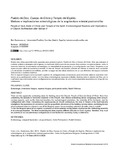Mostrar o rexistro simple do ítem
Pueblo de Dios, Cuerpo de Cristo y Templo del Espíritu: matices e implicaciones eclesiológicas de la arquitectura eclesial postconciliar
| dc.contributor.author | Daelemans, Bert | |
| dc.date.accessioned | 2020-04-17T11:17:16Z | |
| dc.date.available | 2020-04-17T11:17:16Z | |
| dc.date.issued | 2020 | |
| dc.identifier.citation | Daelemans, B. (2020). Pueblo de Dios, Cuerpo de Cristo y Templo del Espíritu. Actas De Arquitectura Religiosa Contemporánea, 6, 2-25. https://doi.org/10.17979/aarc.2019.6.0.6209 | es_ES |
| dc.identifier.issn | 2340-5503 | |
| dc.identifier.uri | http://hdl.handle.net/2183/25358 | |
| dc.description.abstract | [Resumen] Existen dos ideas aparentemente opuestas para pensar la Iglesia: Pueblo de Dios y Cuerpo de Cristo. Más que subrayar el carácter unitario o jerárquico de la Iglesia, su trasfondo bíblico permite reconocer otros acentos complementarios, como la inserción histórica, la orientación escatológica, la centralidad de la eucaristía y la configuración con Cristo. Respecto a sus repercusiones sobre la arquitectura eclesial, la idea de Templo del Espíritu, además de reforzar la vivencia de la comunión y la dimensión sinestésica del edificio, permite conjugar las dos ideas anteriores en un uso dinámico del espacio evitando reducciones a modelos estáticos. Vivir el espacio litúrgico como sucesión orgánica de configuraciones comunitarias pone el acento sobre la asamblea celebrante en su participación activa. Las tres ideas eclesiológicas expresan actitudes distintas ante el misterio de Dios, por lo cual habrá que entenderlas como configuraciones complementarias de una misma asamblea eucarística a lo largo de una celebración. | es_ES |
| dc.description.abstract | [Abstract] There are two apparently contrasting ideas for thinking about the Church: People of God and Body of Christ. More than underlining the demotic or hierarchic character of the Church, their Biblical embedding allows recognizing other complementary aspects, such as the historical insertion, the eschatological orientation, the centrality of the Eucharist, and the configuration with Christ. Concerning the repercussions on church architecture, the idea of Temple of the Spirit not only strengthens the experience of communion and the synaesthetic dimension of the building, but also allows combining the two aforementioned ideas in a dynamic use of the liturgical space, hence avoiding reductions to static church models To live the liturgical space as an organic succession of communitarian configurations emphasizes the celebrating assembly in its active participation. The three ecclesiological ideas express different attitudes to God’s mystery: therefore, they must be understood as complementary configurations of one Eucharistic assembly during a celebration. | es_ES |
| dc.language.iso | spa | es_ES |
| dc.publisher | Universidade da Coruña | es_ES |
| dc.relation.uri | https://doi.org/10.17979/aarc.2019.6.0.6209 | es_ES |
| dc.rights | Atribución-NoComercial 4.0 España | es_ES |
| dc.rights.uri | http://creativecommons.org/licenses/by-nc/3.0/es/ | * |
| dc.subject | Eclesiología | es_ES |
| dc.subject | Dinamismo litúrgico | es_ES |
| dc.subject | Espacio litúrgico | es_ES |
| dc.subject | Participación activa | es_ES |
| dc.subject | Rudolf Schwarz | es_ES |
| dc.subject | Ecclesiology | es_ES |
| dc.subject | Liturgical dynamism | es_ES |
| dc.subject | Liturgical space | es_ES |
| dc.subject | Active participation | es_ES |
| dc.title | Pueblo de Dios, Cuerpo de Cristo y Templo del Espíritu: matices e implicaciones eclesiológicas de la arquitectura eclesial postconciliar | es_ES |
| dc.title.alternative | People of God, Body of Christ, and Temple of the Spirit: Ecclesiological Nuances and Implications of Church Architecture after Vatican II | es_ES |
| dc.type | info:eu-repo/semantics/article | es_ES |
| dc.rights.access | info:eu-repo/semantics/openAccess | es_ES |
| UDC.journalTitle | Actas de Arquitectura Religiosa Contemporánea | es_ES |
| UDC.volume | 6 | es_ES |
| UDC.startPage | 2 | es_ES |
| UDC.endPage | 25 | es_ES |






